Benefits of extending the growing season
Desert regions, especially the high deserts, have wide-ranging temperatures that can greatly stress plants and reduce production. Using a combination of strategies to moderate environmental extremes and protect plants from frost can greatly improve growth and production.
The techniques described in this document are based on understanding and modifying the growing area, using plants adapted for local conditions and using protective structures.
Selecting and establishing the growing site
The climatic history of the growing region normally can be retrieved from the Internet based on long-term weather data collection (Western Regional Climate Center). This data is useful in showing the probability of first and last frosts of the season and temperature variability for each month. Evaluation of the growing site climate can be extrapolated from its proximity to the general climate recording site for the growing area. For example, colder when more north facing or warmer nights if upslope a few feet.
To start your growing season earlier in the spring or extend it later in the fall and into the winter, chose a local warm spot for growing plants. Locations, where the dog or cat curl up in the sun for a nap during the winter, indicate a warmer microclimate area for growing plants. Warm spots are situated so that cold air does not accumulate and persist. Cold drafts are directed elsewhere and do not flow through the area.
Sun exposure
The growing area should have sunlight shining on it for most of the day during the fall, winter and spring. Remember the angle of the sun decreases to the south during the fall and winter. The amount of solar energy and warmth also decreases. Therefore, it is important to locate and position your growing area to capture as much solar energy as possible.
Slope and elevation
The slope and elevation of the land affect how cold it will get at night since cold air is heavier than warm air and sinks. Avoid growing cold sensitive plants in a valley bottom and low pockets because cold air will collect into these areas. In hilly and mountainous areas the low temperatures are usually several degrees warmer on a hillside because the cold air sinks down to the valley floor. Although the climate is usually warmer on the hillsides, the soil quality is often too poor to produce well. Selection of the growing site will have to consider these factors with soil quality being important.
The direction that a slope faces impacts how well the sun is able to warm the soil and plants. Slopes that are south and/or west facing collect the most sun exposure and heat. For late fall through early spring production, landscaping the soil surface perpendicular to the sun will increase heat collection.
Wind protection
Winds, especially cold winds, can greatly reduce plant productivity. Establish a shelter belt to provide protection from prevailing winds. Trees, shrubs, and/or fences can form the shelter. Wind shelters located upslope of the planting area can effectively trap or redirect sinking cold air from higher elevations. If you have a high value crop, wind machines can be used to mix cold air sinking into low areas with warm air.
Soil
Darker-colored soils absorb and store more heat from the sun than lighter-colored soils. Soils with a clay or loam texture have less daily temperature variation and cooler minimum temperatures than dry, sandy and peat soils. Sandy soils heat up quicker in the spring and may produce an earlier coolseason crop.
Water
Water absorbs and stores heat which creates a buffer from temperature extremes. Use irrigation timing to slow and possibly reduce temperature extremes. Moist soil absorbs and radiates more heat than dry soil. Irrigating as temperatures drop into freezing can protect the plants for several degrees. This frost protection works for flood or drip irrigation on the soil or more commonly through sprinklers on the plants. Start irrigation before the temperature drops to 34 - 27 degrees F and early enough to get adequate moisture.
Irrigating before the hot period of the day during the summer can lower the temperatures near the ground surface due to water absorbing the solar energy and evaporative cooling.
Plant selection
Choose plants that are suited to the climate and season. The United States Department of Agriculture (USDA) growing zones provide good general information on what plants are suited for a region. Choose plants that are hardy to cold temperatures during colder seasons. Many greens, such as kale, spinach, mustard and romaine winter lettuces, are cold tolerant to well below freezing, if they are slowly acclimated to cold temperatures. Root crops, such as carrots, parsnips, beets, onions, leeks and garlic also tolerate cold temperatures and can be dug up, when desired, during the winter.
Cold tolerant greens (left) and garlic (right) in January. Lincoln County UNCE
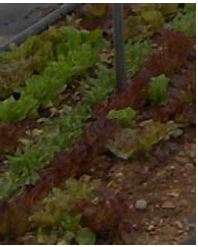
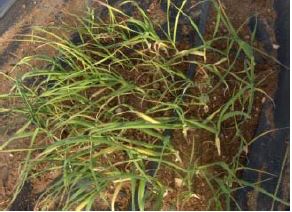
For the summer season, select early maturing varieties of crops that perform well in regions with wide temperature swings – i.e. Early Girl tomatoes.
Plants started inside and transplanted outdoors can provide a gain of three to four weeks on the season and help decrease weeds. Starter plants usually perform best if they are not too large. The transplants must have a healthy root system that is proportional in size (nearly the same size) to the top of the plant. The Curcurbitacaea plant family (cucumber, squash and melons) often have their growth stunted for several weeks after transplanting and may perform better through direct seeding.
Structures to extend the season Raising the growing area
An elevated growing area accomplished through raised rows or raised beds warm the growing area by capturing sunlight and avoiding some of the cold air.
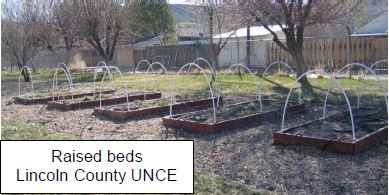
Hot caps and boxes
For centuries, gardeners have used hot caps over individual plants (or a few small plants) to create a warmer environment. A hot cap is anything that covers a plant to retain the heat around it. Historically, large jars with the bottom cut out were used for this purpose. There have been many variations such as old tires with one rim cut off, turned inside out and covered with a glass or plastic panel. Another common technique is the use of hot boxes. This is a small, low box with a clear top for sunlight access for growth and warmth. Both hot caps and boxes can greatly increase the temperature around the plants allowing winter production of personal-use vegetables in many areas of the United States.
Floating row covers or frost blankets
In recent years, a common practice employed to extend the season for larger growing areas is to use floating row covers or frost blankets. Floating row covers are cut long and slender and cover one row.
Frost blankets are made of the same material and are only different by covering a large area such as several rows or a hoop house. Row covers can provide protection from the cold, wind and insects.
There are several products on the market that consist of lightweight synthetic materials that “float” on the plants. Floating row covers do not require a structure to hold them up over the plants but do require anchors such as pins, stones or soil to hold them down in the wind. The material allows water and light through yet holds in the warmth.
Floating row covers vary in weight and correspondingly in the degree of protection provided. Lightweight row covers (0.3 to 0.6 ounce weight) provide light protection for a few degrees of temperature and the wind. Light weight covers let up to 85 percent of the solar energy through. Medium weight covers provide a moderate protection while heavy weight covers (1.5 ounce weight) can provide an additional 7 – 24 degrees F of protection. Heavyweight covers let about 50 – 65 percent of the sunlight through. In warmer climates like the Las Vegas area, growers often will use a light- or medium-weight cover during the winter largely for wind protection. In colder higher desert climates, the heavyweight floating row covers are very effective. Often, a lightweight cover will only last one season in moderate wind, where a heavyweight cover may last for two or three years. The degrees of frost protection and durability of the fabric can vary between manufacturers so it is important to compare prices and products carefully.

Low tunnels
Low tunnels are small tunnels temporarily constructed over one or two rows of crop. These tunnels are low in cost and are often constructed of clear plastic tightly fitted over wire hoops. Grower supply companies sell precut wire hoops and plastic with slits for ventilation. Homemade systems can be made by using #10 gauge wire and clear plastic. Low tunnels can be constructed over grower boxes.
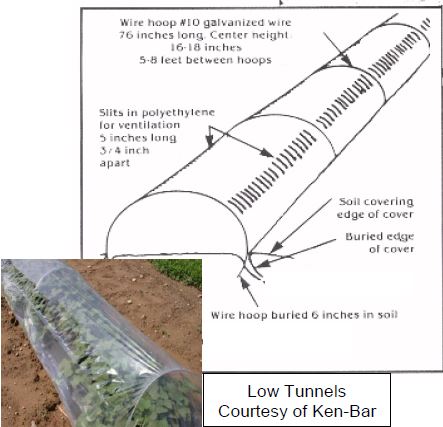
As shown in the following picture, PVC painted with external latex is used as the frame that clear plastic can be fitted over during the spring and fall.
Low Tunnel Over Raised Box Photo courtesy Lincoln County UNCE
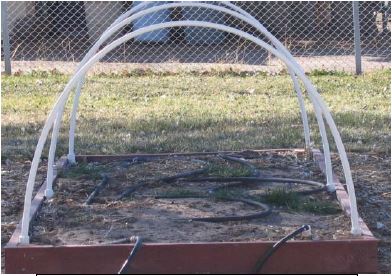
Mulch
The term mulch in gardening literature is used to describe when plastic or some other material is laid on the soil surface. For the purpose of season extension, plants are transplanted or seeded in slits cut in plastic. The color of the plastic can vary but is intended to capture and reflect sunlight into the ground to heat the soil and help the plant mature. Plastic also reduces weeding and weed competition. Pennsylvania State University Center for Plasticulture (2009) researches the effect of plastic mulch.
Plastic Mulch Photo courtesy of Pennsylvania State University Center for Plasticulture
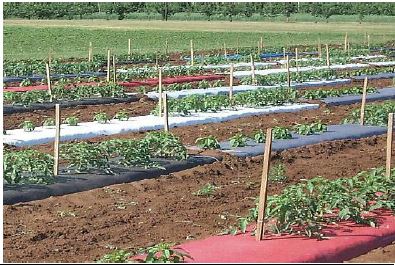
Hoop houses
Also called high tunnels, hoop houses are relatively simple structures somewhat similar to greenhouses. However, unlike greenhouses, hoop houses are typically:
- Simple structures, constructed using relatively inexpensive materials, built to last several years rather than decades.
- Passively solar heated.
- Tall and wide enough for a person to stand and drive light tillage equipment in.
- Designed to allow growing season extension but not necessarily year-round crop production.
Benefits of hoop houses
The primary use of hoop houses is to extend the growing season by adaptation of the environment and protection of plants. They can provide more control on temperatures during cold seasons, protect from wind and storms and are more easily moved than most greenhouses. Researchers in Wisconsin reported that the use of hoop houses extended their growing season by an additional six to eight weeks (Larson, 2009). In Colorado, researchers reported that use of a mobile hoop house extended their growing season by 110 days (Page, 2008). Oregon and Missouri growers also found that using hoop houses helped to improve crop diversity, quality and harvest overall (Agnew, 2006; Berblinger, 2008).
Winter production in hoop houses Lincoln County UNCE
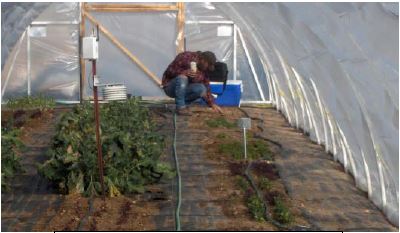
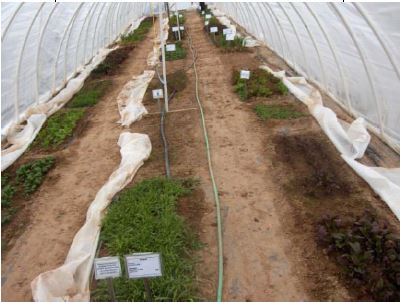
Location and Design
Site selection for a hoop house is critical. It should be located in well-drained, fertile soil that is free of serious pathogens and weeds. The tunnel should be positioned so that it captures the winter sun as much as possible and avoids shading, especially from the south and west sides. To minimize wind damage, it is important to orient the tunnel with its length running with the dominant wind direction for the site. It is important to allow space around the hoop house to avoid shading and so snow can slide off.
The tunnel needs to be located near a year round water source such as a freeze-free tap. While hoop houses are not generally heated, access to electrical power may also be beneficial, especially if you want to have the option of using heat tape or other localized heat sources when starting plants in late winter or early spring.
If possible, create a system for passive ventilation. It is not unusual for temperatures to exceed 100 degrees F in a tightly closed hoop house even though outside temperatures only reach 50 or 60 degrees F. Opening the ends of the hoop house and rolling or lifting the plastic on the sides of the tunnel will provide adequate ventilation. However, if someone is unable to monitor temperatures regularly and open the hoop house manually, a thermostatically controlled ventilation system may be needed.
Hoop house with sides raised for ventilation Lincoln County UNCE
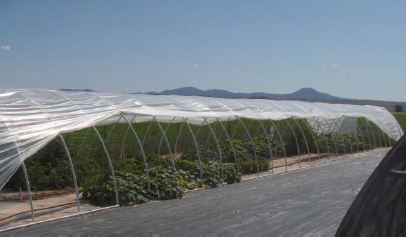
Several construction features can extend the useful life of hoop houses (Black, et. al., 2008). First, ensure that the tunnel is tall enough for workers to stand and work freely throughout its length. If the hoop house is too low or small, it is not only difficult to monitor and care for plants, it is easy for the covering and structure to be damaged by tool handles and tillage equipment.
Second, painting the structure with exterior latex paint will generally extend its useful life. Avoid connections in PVC; they tend to become brittle and break sooner than the pipe itself. Third, don’t make the structure too rigid; flexibility in the wind helps to minimize damage. Anchor the ends of the hoop house securely to posts. Tie or otherwise secure the PVC arches securely to the main ridge pole but be sure to keep the outside, by the plastic, smooth. Finally, keep spare parts on-hand for repairs.
Shade cloths are available in a range of densities and can improve plant growth during the heat of the summer. They may be used to even out temperatures extremes, provide protection from wind and storm damage and reduce damage from insects, birds and animals.
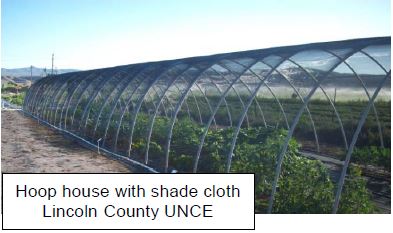
Summary
Several management decisions and tools can greatly help to extend the growing season for plants. Choose a naturally warm growing site where the sun shines and cold air doesn’t collect. Raise the growing surface to increase warmth during cool seasons. Time watering to help moderate cold or hot temperatures. Select plants and varieties that fit the climate and local growing conditions. Finally, consider covering the crop with one or more layers for protection.
Bibliography
Agnew, S. (2006). High Tunnels Extend Growing Season and Increase Profits. Missouri Vegetable Growers Association Quarterly News for Vegetable Growers, University of Missouri Extension. Retrieved Sept. 10, 2009 from High Tunnels Extend Growing Season and Increase Profits
Bachmann, J. (revised 2008). Season Extension Techniques for Market Gardens. ATTRA. National Sustainable Agriculture Information Service. Season Extension Techniques for Market Gardens
Berblinger, A. (2008). Season Extension at Gales Meadow Farm. Oregon State University Extension Service, Small Farms. Retrieved Sept. 10, 2009 from Season Extension at Gales Meadow Farm
Black, B., Drost, D., Rowley, D., Hefleb, R. (2008). Constructing a Low-cost High Tunnel. Utah State University Cooperative Extension. Retrieved Sept. 10, 2009 from Constructing a Low-cost High Tunnel
Center for Plasticulture. (2009). Pennsyvannia State University. Retrieved Sept. 10, 2009 from Pennsyvannia State University
Larson, B. (2009). Extending the Gardening Season. University of Wisconsin Extension. Retrieved Sept. 10, 2009 from Extending the Gardening Season
Page, E. (2008). Season Extension and Crop Area Multiplication with a Moveable Hoophouse in an Organic System. Western SARE. Retrieved Sept. 10, 2009 from Season Extension and Crop Area Multiplication with a Moveable Hoophouse in an Organic System
Cooperative Extension Service, College of Agriculture, University of Kentucky (2009). Season Extension Tools and Techniques. Retrieved Sept. 10, 2009 from College of Agriculture, University of Kentucky (2009)
Thank you to USDA-CSREES for funding this project.
Gatzke, H., McCuin, G., and Nelson, D.
2009,
Plant Season Extension in the Desert,
University of Nevada Cooperative Extension


